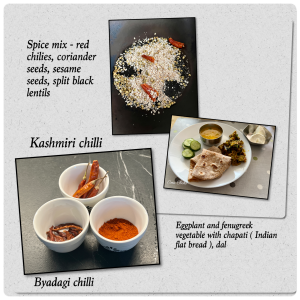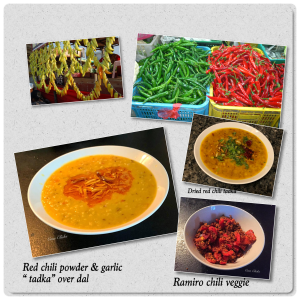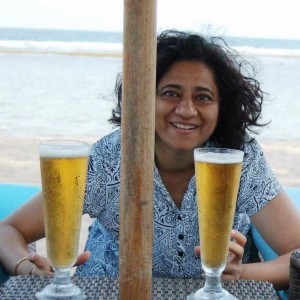Back from the summer break and now on to the next spice level. The most vibrant, bright red, showstopper spice is the chilli, a must have in the Indian cooking. Apart from adding flavour to our dishes, they also have medicinal properties and consuming them in the right amounts is the way to enjoy them.
Chillies are used in our cooking in several ways: adding heat, tempering, in marinades and for pickling. Some of the varieties of chillies like Kashmiri or Byadgi are used predominantly for its colour as they are milder in its flavour. They are used either, as whole, or in a powdered form. I am still a learner in terms of understanding these chilli powders and the use of them. Sometimes I have mixed the two varieties, the spicier and the milder version and tried to get the best of them. There are many different varieties of chillies and, of course, the spiciest of the variety is Bhut Jolokia, the ghost pepper.
Then again, “Appearances are often deceiving,” rightly said by Aesop – The Ramiro Red chilli, the one I found here, a fiery red colour. One would expect it to be really hot, but it turns out to be very mild & flavourful, when chopped into small pieces and blended in well with a spiced chickpea flour. This is how we enjoy it with our chapati- Indian flat bread.
We used the fresh green chilli in the tadka i.e., tempering and then use chilli powder if more heat and spice is needed later in the cooking. Another way of using (red) Indian chilli powder or dried red chilli is to use in the second tempering where in its flavours are extracted and it adds colour, aroma to the prepared dish.
The ripened chillies are usually sun dried and then ground to make the chilli powder. Now one wonders why we add green chillies or red chilli powder and how exactly we use it. Green chillies are usually added in the first tempering, after the mustard seeds and turmeric, so the spiciness is incorporated in the oil before adding the chopped vegetables and transferring the heat to them. Usually, chilli powder is added later after sautéing the vegetable or lentils. At times both are added, depending on how spicy or hot one wants, or for the looks along with the flavours. In the second tempering, dried red chilli or powdered chilli is added to the finished dish, thereby adding an appetising look and flavour, further enhancing the dish.

 Sometimes we mix and match different spices when making different kinds of vegetables or lentils. First, we dry roast the spices and then grind them, this spice mix is then added to the vegetable in the last stage of cooking. This spice mix is a game changer in terms of taste and so different from when individual spices are added separately. For example, for the eggplant & fenugreek vegetable a spice mix is made with roasted and ground dry red chilli, coriander seeds, sesame seeds, split black lentils.
Sometimes we mix and match different spices when making different kinds of vegetables or lentils. First, we dry roast the spices and then grind them, this spice mix is then added to the vegetable in the last stage of cooking. This spice mix is a game changer in terms of taste and so different from when individual spices are added separately. For example, for the eggplant & fenugreek vegetable a spice mix is made with roasted and ground dry red chilli, coriander seeds, sesame seeds, split black lentils.
In the oil add mustard seeds, turmeric, when they splutter add in chopped onions, ginger, garlic and once they are cooked add in cubed eggplant, fenugreek leaves, tomatoes, sauté it and then add water and cover and cook for some time and then add the prepared spice mix and salt. Later, once the eggplant is cooked add lime juice or dried mango powder. Garnished with chopped coriander, the dish is ready to be served.
“Eating spicy food releases “feel good” endorphins, making it one of the reasons why people enjoy it so much.” – Anonymous. Now it rings a bell, doesn’t it?

Seema Ganoo
Engineer by education, passionate photographer & food enthusiast from India, living in Vaasa, and is happy to contribute to this column which combines her love for food & photography.




